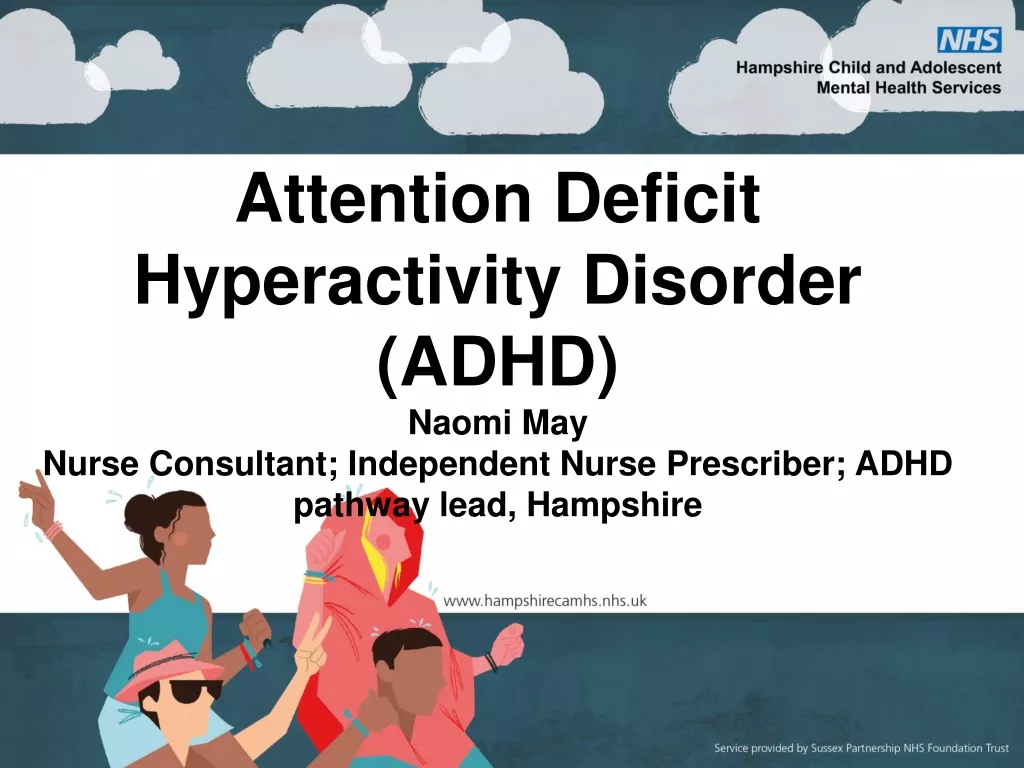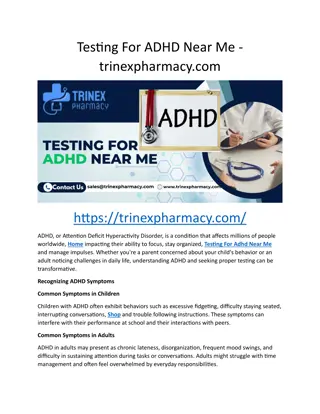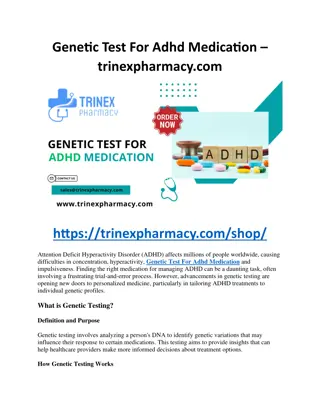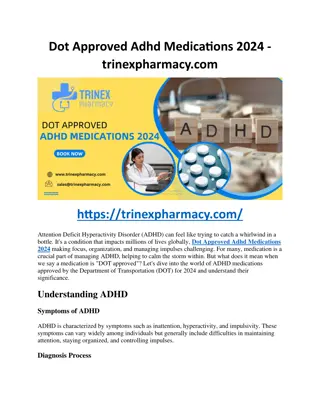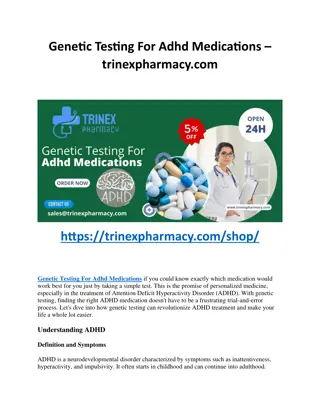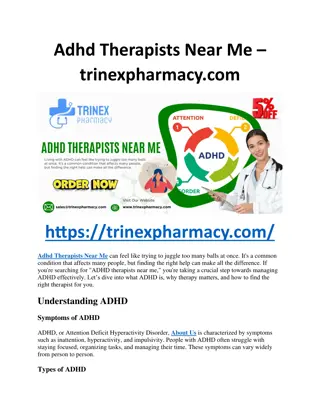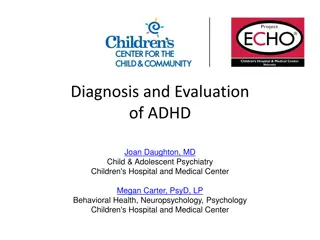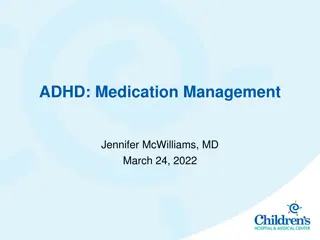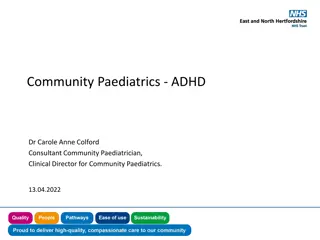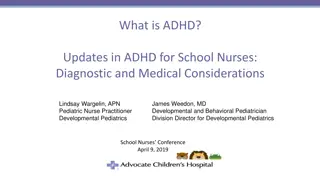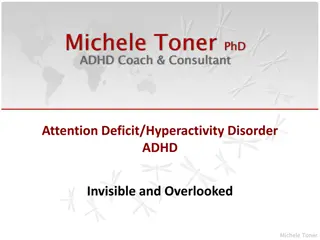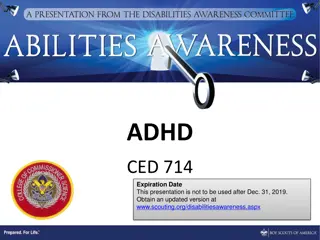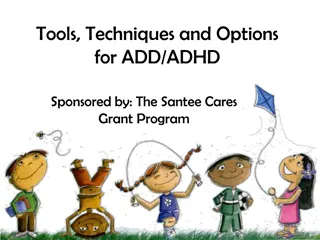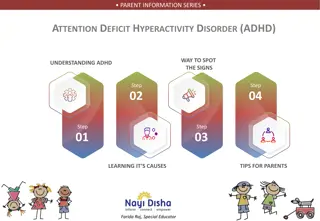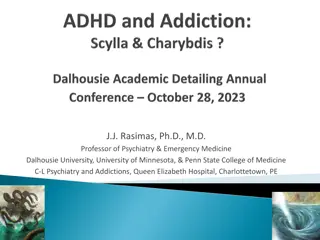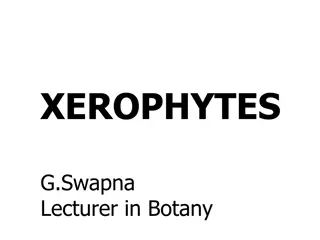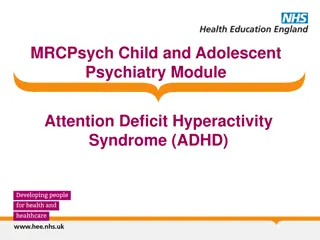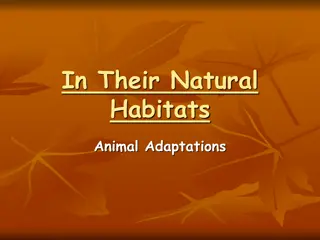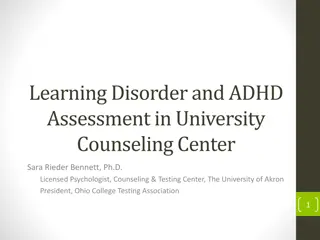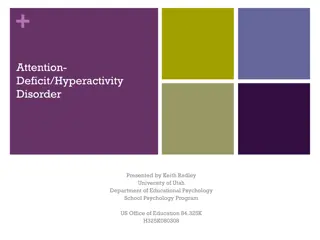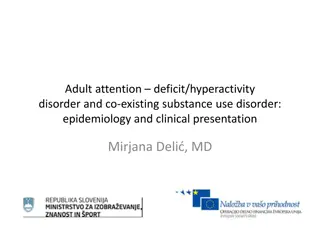Supporting ADHD Students in the Classroom: Effective Strategies and Adaptations
Understanding and supporting students with ADHD in the classroom is crucial for their academic and social development. This bulletin provides valuable insights and practical strategies to create an ADHD-friendly learning environment. Key points include creating quiet areas, establishing routines, incorporating brain breaks, and organizing the classroom for optimal focus and minimal distractions. By implementing these adaptations, educators can enhance the learning experience and support the unique needs of students with ADHD.
- ADHD support
- Classroom strategies
- Neurodevelopmental condition
- Behavior management
- Inclusive education
Download Presentation

Please find below an Image/Link to download the presentation.
The content on the website is provided AS IS for your information and personal use only. It may not be sold, licensed, or shared on other websites without obtaining consent from the author. Download presentation by click this link. If you encounter any issues during the download, it is possible that the publisher has removed the file from their server.
E N D
Presentation Transcript
BITESIZE BEHAVIOUR BULLETIN NUMBER 2 The ADHD Friendly Classroom
Do you teach a child who displays a high level of the following behaviours? 1. Easily distracted 2. Difficulty settling to activities 3. Restless 4. Fidgety 5. Noisy 6. Continually on the go 7. Frequently interrupts, talks out of turn The child may have ADHD.
ADHD is used to describe people who exhibit long-term difficulties that include inattention, hyperactivity and impulsivity. Hampshire County Council EPS, 1996 Attention Deficit Hyperactivity Disorder (ADHD) is a neurodevelopmental condition whereby individuals find it difficult to focus their attention and to control their behaviour. Individuals with ADHD usually cannot concentrate for very long and may do or say things without thinking of the consequences. LANC.org.uk
Adaptations to the behaviour management An ADHD friendly classroom needs Adaptations to all aspects of teaching and learning Adaptations to the environment
Have a quiet area that is available for all children. Create a time out pass card which the child can use independently. Have timers so the amount of time is restricted. Limit then number of passes- say three for the morning and 3 for the afternoon Make sure the classroom is well-organised, tidy and calm. Look at communication friendly classrooms. They are usually aesthetically pleasing, have minimal clutter, resources clearly organised and labelled and display neutral colours to minimise stimulation Teach children how to organise their desk, time. Some ADHD children benefit from a mini-office within the classroom with a small screen around. This can help children to remain focused for a period of time It s good for children with ADHD to walk even for 2 minutes for every 10 minutes of sitting or less depending on the age of the child. Be proactive in reducing the anxieties creeping in by allowing the child to have these frequent brain breaks Lighting is important for ADHD children. Natural light is better but make sure on sunny days there are blinds to reduce the light and ensure the room is well-ventilated. If strip lighting is used be aware of where the child sits in relation to the lights. If possible don t have all the rows of lighting on at the same time Establish and display a daily routine- an individual visual timetable can help and some children like to tick off the sessions completed Be proactive rather than reactive. Be aware of problem situations (change of timetable, change of teaching staff, new classroom layout, school outing or visitor- RAG the day with the child if possible Accommodate skills difficulties to reduce the anxiety Acknowledge and note vulnerabilities Find out potential problems before the child enters the class so you can plan ahead and avoid the possibility of a poor start Assess situations with the ADHD child in mind. School trips or a school play are likely to make the child very excited. Establish one or two essential rules before the event and make sure the child knows what the expected behaviour looks like and what will happen if she/he does or does not comply. Consider grouping the child with less children and with those who are a calmer influence Try to control the level of stimulation the ADHD child is exposed to. A child with ADHD is easily aroused Give short, clear instructions. Try not to flood the child with information as s/he will switch off Pedagogy must be interactive. All children take ownership of their learning if they are doing. This is even more important for the ADHD learner Don t presume the child will behave well because of getting a reward Teach the child problem-solving skills and calm down strategies so he feels in control. Remember feelings of helplessness are close to feelings of depression Make changes to the behaviour policy to maximize success Have only few rules in the classroom: make sure they are visible and child knows the rules and consequences of compliance or non-compliance Rules should be phrased positively. Praise and reward appropriate behaviour and achievements-try to ignore minor behaviour Enforce rules consistently and quickly: ADHD children cannot await rewards and forget why they are receiving a consequence if there is a delay Reinforcement and meaningful rewards help and are more effective than punishment, as is a positive attitude, comment or smile Set boundaries and limits for children in a classroom or playground. Be clear and direct Make it clear it is the behaviour not the child that is unacceptable Reframe your language. Tell the child what to do, rather than what not to do, eg, Feet on the floor please rather than take your feet off the table. Giving positive rather than negative instructions are better for morale of teacher and child Work on one difficult behaviour at a time. Remember you are teaching the child to behave just as you teach him to read. All children benefit from a curriculum for teaching them how to behave but an ADHD learner needs this to be differentiated to them Catch them doing it right. Praise to correction of behaviour in a 4:1 ratio Be ready to offer stimuli-free time out to give the child headspace and time to reset. Behaviour Management The Environment Teaching and Learning
Whilst ADHD can co-occur with other disorders, some disorders also have strong overlaps in symptoms with ADHD (such as ASD or ODD). People often confuse ADHD and ASD presentations. It is important to recognise the difference as the access to support pathways is very different. Below are some of the key features that distinguish the two (for individuals who do not have ADHD and ASD comorbidities). .
What Teachers Don't Know About ADHD?
Reframe the ADHD Remember the child is NOT doing it on purpose- ADHD is a medical condition which requires specific support Understanding and accepting ADHD coupled with the desire to adapt teaching and learning strategies can empower ADHD learners to learn more effectively Children with ADHD are already harsh self-critics so they struggle to deal appropriately with criticism and can become hostile and defiant Change the problem into an opportunity.
REFRAME what you see A problem? Or an opportunity Easily distracted Acutely aware with high levels of observation Restless Energetic and lively Goes off at a tangent Sign of individualism and independence Forgetful Absorbed in their own thoughts Always interrupting Enthusiasm for contributing Sloppy, rushed work Reward the effort despite the difficulties Being selfish Single-mindedness in pursuit of goals Try to reward good development and ignore the development you don t want. A growth mind-set approach may maintain a positive relationship with ADHD learners.
The Ideal Teacher for the ADHD learner Accepts ADHD and is knowledgeable about the condition; Enforces rules with flexibility and remains positive and calm; Modifies pedagogy and resources to suit learning style; Makes the day as kinaesthetic as possible; Creates opportunities for success; Knows when to ease off when a child s frustration level start to peak; Speaks clearly in brief, understandable language; Runs a predictable and organised classroom; Demonstrates good control of the classroom but not controlling; Provides immediate and consistent feedback relating to behaviour; Has a private communication system with child to notify of any off-task/inappropriate behaviour; Close proximity to child without being intrusive; Uses tactical ignoring and knows when to intervene or ignore; Knows what motivates the child and uses this effectively. What could you do differently?
ADHD Websites ADDISS www.addiss.co.uk ADDISS (National Attention Deficit Disorder Information and Support Service) is the UK s only national ADHD charity. ADDISS provides a wide range of information and resources about Attention Deficit Hyperactivity Disorder to parents, sufferers, teachers and health professionals. They also run annual conferences, training and a telephone helpline. Adders.org www.adders.org Set up in 1998, this site aims to promote awareness of ADHD and provide information and practical advice to sufferers and their families in the UK and around the world. Lots of information, downloadable resources and a comprehensive list of local support groups. ADHD Foundation www.adhdfoundation.org.uk The ADHD Foundation is based in Liverpool and provides services to ADHD sufferers and their families in that area. However, their website has a lot of information on ADHD, including a very detailed FAQ Living with ADHD www.livingwithadhd.co.uk This is a website from one of the pharmaceutical companies, Janssen, but it includes a lot of information for teenagers with ADHD as well as parents, teachers, and medical professionals, including videos and downloadable resources. YoungMinds www.youngminds.org.uk YoungMinds is the UK s leading charity committed to improving the emotional wellbeing and mental health of children and young people. The link will take you directly to the ADHD section.
Useful Resources ADHD GUIDE FOR TEACHERS Hi It s Me, I have ADHD by Katelyn Mabry, 2020. The Survival Guide for Children with ADHD by James Taylor, 2013. Super Emotions! By Lionel Lowry, 2013.


